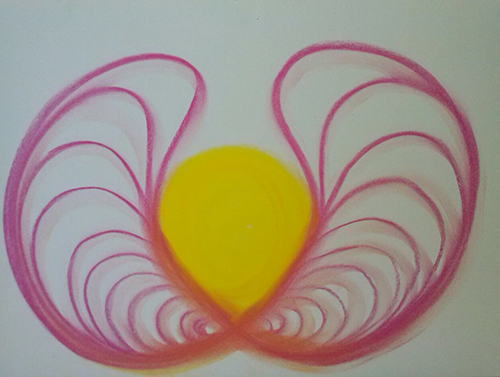Painting Therapy for Pain in Palliative Care
Astrid Didwiszus
Last update: 29.04.2020
“By giving expression to our distress through art, we create spaces where suffering – and life – are possible under human conditions.” (1, p. 142)
However, creative activity can be more than just an expression of a person’s suffering, it can be a means of overcoming it and helping the patient to regain an inner sense of balance. In art therapy with seriously and terminally ill people, it is not only a matter of accompanying the psychological and physiological consequences of the illness but also of opening up a space beyond being ill. In this way, people in palliative situations can develop new perspectives, experience a certain ability to act and acquire a feeling of autonomy.
Pain happens when a person’s soul body penetrates too deeply into the physical body. Painting therapy helps to ensure that the governing principles of the soul body once again take hold of and penetrate the person’s etheric processes to a greater extent, thereby releasing them from the physical. Pain greatly reduces the patient’s range of perception. The patient’s window of perception can be broadened again through therapeutic painting and a new way of dealing with pain can be found that takes into account the person’s inner resources for influencing and dealing with pain on a physical, mental and spiritual level.
The goals of painting therapy are: to access and promote the ability to express emotions, needs and experiences; improve the ability to relax and deflect one’s attention from the experience of pain; release physical and psychological blockades; help the soul to “breathe”; arouse interest and enthusiasm; activate resources, process the illness, find meaning and, last but not least, promote self-regulation.
Therapeutic recommendations
First and foremost, we need to form a relationship. After making initial contact, we clarify whether the patient is ready to engage in painting therapy and if so, how much strength he or she has, i.e., whether he or she can participate in a painting therapy group or whether the painting can be done at the bedside – actively or perhaps receptively.
Using a wet-on-wet watercolor technique has proven to be very successful, as it especially promotes releasing processes in the sense of exhalation and relaxation.
- Color lightening: proceed from heaviness into lightness and from narrowness into vastness, e.g., with the color blue (2) We can also take up colors and qualities of an initial independent painting made by the patient and transform and harmonize them step by step.
- In addition, the patient can practice color connections/transitions (soul “breathing”).
- Painted breathing exercises according to Dr. Margarethe Hauschka (3).
- Interest and enthusiasm can be aroused by choosing favorite topics: by painting stabilizing inner pictures of memories or experiences.
- Dynamic form drawing (according to Elke Frieling) to stimulate flowing movement, rhythmic breathing and a harmonious interplay between binding and releasing, tension and relaxation, as well as to harmonize the sleep-wake rhythm, which is often disturbed by pain. The movements and activities of the soul need the flow of the formative forces of the etheric body to become effective.
- Fairy tales show ways out of hopeless situations and give confidence. Death and suffering are often situations of transition or passages to a new, different life (that has meaning). The stories can stir something in the listener and start a process of change.
- For some patients, the emphasis may be on defocusing the pain experience, on achieving fundamental expansion of the soul and inner space. For others, it may be necessary to establish a secure connection with the body first – e.g., for patients with severe anxiety who need something secure to hold on to – because they are afraid of losing themselves if they feel too strong a release. In such cases the following form drawing exercise has proven very helpful:
- “Lotus figure-eight” : an exercise to form a protected area,
a protective mantel, to take care of oneself: this inner space can be explored, enlivened, warmed and expanded and finally reclaimed as a space of one’s own. The soul is helped to come back from the periphery, to center itself. In a subsequent step the patient can transfer this gesture onto his or her own painted picture.

Fig. 1: Lotus figure-eight. © Astrid Didwiszus
- At this point sculpture is another activity that would also be indicated for patients who are mobile.
- For very weakened patients who suffer from severe pain, music therapy would be preferable to painting therapy, unless the patient wishes to paint.
- We can also use picture dictation , i.e., the therapist creates an inner image according to the patient’s description or draws forms while the patient watches.
- Also, guided picture observations can stimulate the patient’s senses and emotions, as well as stimulate the imagination, thus relieving pain.
“One gray morning when I was feeling very bad, the painting took shape. It began to glow on the paper – as if brought to life by another hand. It was like a miracle to me, just as every creation is a unique miracle.” (4)
Bibliography
- Sinapius P, as cited in: Gruber H, Reichelt S (eds.) Kunsttherapie in der Palliativmedizin. Berlin: EB Verlag; 2016.
- Pütz RM. Kunsttherapie – eine Alternative zur Regeneration des Menschen. Vol. I. Bielefeld: W. Bertelsmann Verlag; 1981.
- Hauschka M. Eine malerische Atemübung. Sonderdruck aus dem «Staedtler-Brief» Nr. 16. Nuremburg: J. S. Staedtler (undated).
- Meves C, as cited in: Sinapius P (ed.). So möchte ich sein – Krankheitsbewältigung bei Krebs – Bilder aus der Kunsttherapie. Cologne: Claus Richter Verlag; 2009.